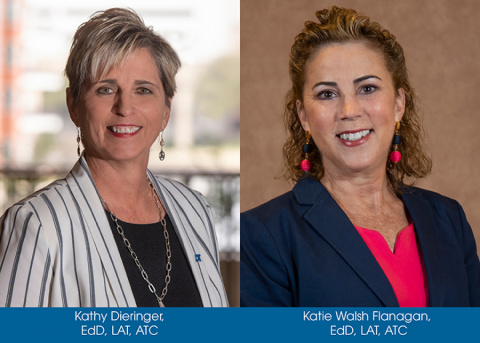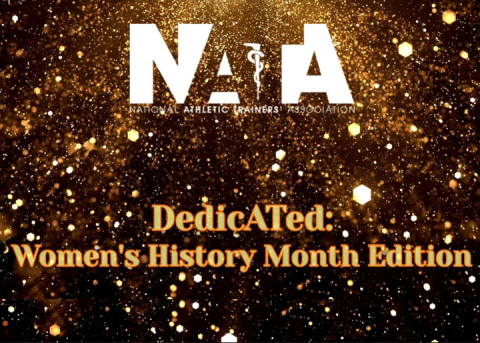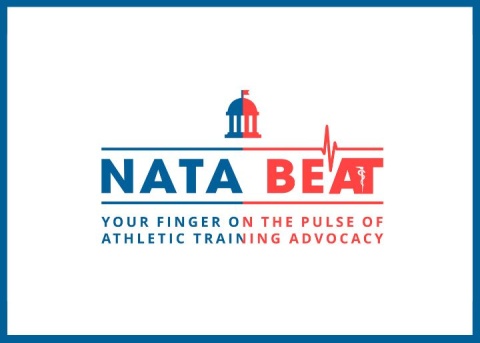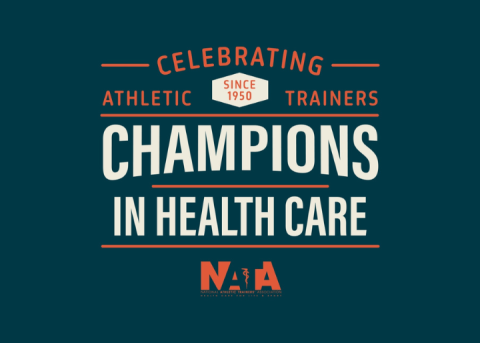
NATA News CORRECTION: An error was printed on page 19 of the March NATA News. The text within Katie Walsh Flanagan’s Presidential Candidate Q&A should have read, “We have to begin to require that athletic trainers work with a physician as a supervisor, not under a coach, AD or non-medical person.” We sincerely apologize for this error.
This year is an election year for the NATA membership. During the NATA Joint Committee Meeting in January, the Presidential Nominating Committee, comprised of two representatives per NATA District, convened to select the final two candidates for the next NATA president. The final two candidates are Kathy Dieringer, EdD, LAT, ATC, and Katie Walsh Flanagan, EdD, LAT, ATC.
With voting taking place this summer, now is a great time to get acquainted with your two presidential candidates. In the coming months, NATA News will include information about the presidential candidates, where they stand on the issues important to the athletic training profession and as people. We will also provide content related to voting and why using your voice this year matters.
The new president will take over for NATA President Tory Lindley, MA, ATC, at the 72nd NATA Clinical Symposia & AT Expo in 2021 and will serve a three-year term. Learn more about this year’s election in future issues of NATA News, on NATA’s social media channels and on the presidential candidate webpage.
Kathy Dieringer, EdD, LAT, ATC
CURRENT POSITION: President/Owner, D&D Sports Med, Aubrey/Sanger/Denton
CAREER: President/Owner, D&D Sports Med (2003-present); Adjunct Faculty, Moravian College (present); Adjunct Faculty, University of St. Augustine (2016-present); Facility Director, Matrix Rehabilitation of Denton (1998-2003); Adjunct Faculty Member, University of North Texas (2002-08); Lecturer and Head Athletic Trainer, Texas Woman’s University, (1987-98); Associate Professor and Assistant Athletic Trainer, Florida State University (1985-87)
NATA INVOLVEMENT: Commission on Accreditation of Athletic Training Education, NATA Representative (2016-present); Fair Practice Employment Work Group (2019-present); ACO Demonstration Project Work Group, Chair (2017-present); NATA Board of Directors, Secretary/Treasurer (2014-16); NATA Board of Directors, District Six Director (2012-16); NATA Board of Directors CMS DME Task Force (2014-18); NATA Nomenclature Work Group (2012-13); NATA Clinical and Emerging Practices Athletic Trainers’ Committee, Chair (2008-12); NATA District Six Convention Committee, Co-Chair (2006-08); NATA Committee on Revenue (2005-08); NATA District Six, President, (2004-05); NATA Women in Athletic Training Committee (2000-03)
WHAT ARE YOUR GOALS IF YOU ARE ELECTED PRESIDENT?
Our profession is entering a pivotal time. Our value is finally being recognized by our stakeholders and relevant decision-makers. We have established and continue to cultivate incredible relationships with strategic physician and organizational partners, relationships that have resulted in positive advances for ATs. NATA must not only continue these, but identify more key decision-makers in every setting and increase our efforts.
Our political footprint is better than it has ever been, and that success has had tremendous impact. With issues such as the opioid crisis, mental health issues and health care access, NATA is poised to be an even stronger voice in our state and federal capitals.
With the recent legislative success in various states across the country, ATs are gaining ground in the political arena. We must increase our resources in this area, which I believe is key to our future.
Although we have clearly changed the dimensions of our original shoe box and have transitioned from being considered “support personnel” to health care providers, the key to our continued success lies in our vision within the global health care system. Our celebrated advances occur when we embrace health care concepts and demand that we are positioned correctly in lockstep with health care. Practicing at the top of our skill set is important, but we must be willing to practice to the depth of our skill set as well, including unique, new health care concepts that will advance the profession. For example, four years ago, the board approved a concept of mine to create the Health Care Reform Workgroup. As a result, the ACO Demonstration Project, now in progress, will provide our profession with irrefutable data that we are valuable health care providers. I commit to finding the resources to support such innovative projects that benefit the entire profession.
WHAT ARE THE MOST PIVOTAL ISSUES FACING THE ATHLETIC TRAINING PROFESSION?
One of the concerning questions we must address is: “Why are so many of our best and brightest leaving the profession?”
We want an AT in every secondary school and club sport, but how can we make that happen when our attrition rate continues to be an issue? We continue to lose some of our best young professionals, and that’s not OK. We know why ATs are leaving the profession, and it’s not because they don’t have the passion or work ethic. Fostering transition to practice must continue to be prioritized and enhanced, preventing this exodus at all costs.
The time to improve our salaries, respect and work-life balance is now. To do so, we must focus on outcomes data to prove our value and impact, raise our credibility and improve the lives of our members. To be respected as health care providers, we must embrace and prioritize health care concepts that have been proven to increase the value of the health care provider. Quality improvement initiatives must become the norm, not the exception, as these are already a driving force in all other health care professions. We know that we are great at what we do, but until we consistently prove that to our patients and communities, we’re at a disadvantage.
Additionally, we must prioritize the protection of the positions we have worked so hard to obtain by creating new avenues of sports science expertise in the professional, collegiate and soon secondary schools settings. ATs should be leading sports medicine programs, not losing these positions to other professions.
Finally, AT educators are the foundation of our profession, and providing the tools and resources to empower AT students is vital. By providing a path to maximize the educators’ impact, we are securing our future as a premier health care provider.
WHY DO YOU WANT TO BE NATA’S NEXT PRESIDENT?
I have a passion for this profession, a passion that didn’t diminish after I served on the NATA Board of Directors. I want to use my unique skill set and my health care and business acumen to give back to the profession that has given me so much. To make athletic training a force in health care, we must embrace all aspects of health care, with all its warts and complications, and see the opportunities it presents:
- To lead in the sports science arena.
- To engage YPs and brainstorm resources to further empower leadership and clinical development.
- To prioritize the goal of autonomous medical decisions in college and secondary schools.
- To excel in quality improvement initiatives.
- To explore settings that value our skill set.
My background is multi-faceted. I have experienced the rewards and challenges of the collegiate, high school and, now, youth sports and clinical setting. I understand the battles every AT faces in terms of work-life balance, salaries and credibility. As a CAATE commissioner, I see the passion of our educators who are driving our profession forward to impact health care delivery and visionary implementation of education, and I’m so appreciative of them. I also understand the economic impact of an AT from a business perspective and the need for these two worlds to occasionally collide.
The path to better salaries, work-life balance and respect is in front of us – we simply have to choose that path. Honor our proud, legendary past by using that foundation to propel us further toward new ideas and innovations. We have the education. We have the skill set. We must now have the will and the courage to look within ourselves, embrace change and be that force in health care I know we can be.
I want to lead that charge.
Katie Walsh Flanagan, EdD, LAT, ATC
CURRENT POSITION: Director of Sports Medicine/Athletic Training/Professor, East Carolina University
CAREER: Director of Sports Medicine/Athletic Training/Professor, East Carolina University (1995-present); Medical Observer, East Carolina University (2015-present); Athletic Trainer, East Carolina University (1995-present); Lecturer/Assistant Professor, California State University at Fresno (1990-92); Head Athletic Trainer, Chicago Power Men's Professional Soccer Team and Illinois Sports Medicine and Orthopaedic Centers (1987-90); Head Athletic Trainer/Lecturer, Western Illinois University (1983-85); Athletic Trainer/Lecturer, Illinois State University (1980-83)
NATA INVOLVEMENT: NATA Board of Directors, District Three Director (2017-present); NATA Clincial Symposia & AT Expo, Volunteer (2016); NATA Honors & Awards Committee (2013-16); NATA Professional Education Committee (2012-15); NATA Clinical Symposia & AT Expo, Special Topics Reviewer (2008-present); NATA Nomenclature Task Force (2003-04); NATA Inter-association Task Force on Exertional Heat Illness (2003); NATA Educational Council, Sub-Committee Competencies (1997-99); Journal of Athletic Training, Manuscript Reviewer (1996-present); NATA National Board of Certification Examination Task Force (1996)
WHAT ARE YOUR GOALS IF YOU ARE ELECTED PRESIDENT?
Due to space constraints, I will focus on my top three:
1. Determine the best practices in evolving education for ATs
We have made giant leaps in education recently, with more changes coming this summer with the new CAATE Standards. As an educator with more than 25 years of experience, and service on the CAATE commission for nine years, I am uniquely qualified to lead this challenge. I will use best practices to address concerns about readiness for the clinical skill gaps mandated in 2020 standards that affect all ATs, in addition to professional preparation to enter the practice of AT.
There has to be a stronger voice for all educators within the NATA membership. The EducATionalist Community is an exciting and necessary aspect of representation, and I intend to protect it as an active and critical component of our membership.
2. Increase medical autonomy
Enforce that we are health care professionals, and we can do so much to increase using the full extent of our training and skill set in a variety of settings.
For too long we have allowed ourselves to work under the schedules and pressure of coaches and athletic directors. It’s time to address medical autonomy in all settings and have a medical supervisor who supports us with patient care as a priority over organizational/ team outcomes.
3. Provide opportunities for continued growth
Broaden our membership: Our membership is about 18 percent ethnically diverse. We must find more ways to encourage, promote and foster the practice of ATs who represent ethnically diverse populations. Increase safe participation: All high school athletes deserve access to an AT. We also need focus on providing medical care to athletes in middle school as well as participants in intramural sports, recreation leagues, club teams and national sport organizations for all ages.
WHAT ARE THE MOST PIVOTAL ISSUES FACING THE ATHLETIC TRAINING PROFESSION?
I will elaborate on four:
1. Education reform
We do not yet know the impact of the master’s degree requirement, raised costs of education and how/if it translates into better salaries. There is still considerable concern over graduate readiness upon completing a two-year program that requires attention. We need to fully explore post-certification education, such as specialty fellowships, residencies and how they interplay with our careers. Are they going to become essential, or are they an added qualification for specific settings?
2. Medical autonomy for all ATs
We have to begin to require that athletic trainers work with a physician as a supervisor, not under a coach, AD or non-medical person. We must have the opportunity to be evaluated, hired or even terminated by patient outcomes, not win-loss record. ATs have the right to be secure that their patient care follows best practice for the patient/ condition and not fear of repercussion or losing one’s job.
3. Reimbursement
Quite simply, National Provider Identifier numbers bring power to lobbyists, and lobbyists increase legislative awareness. Legislation drives regulation/laws and offers greater ability to receive payment for services ATs can render. Greater need for our skills, combined with receiving payment for them, yields greater worth/value.
4. Rise up to level of our training
We are health care, and we are one of the biggest barriers to our own future growth. We need to rise to level of certification and regulation and not be content to practice only our most basic skill set. We have to figure out what we need to do to drive the bus and better advocate for ourselves and patient safety. Right now, too many of us just have a seat on the bus. We can do better to rise up and protect our patients using the full extent of our training.
WHY DO YOU WANT TO BE NATA’S NEXT PRESIDENT?
I want to be our next president because I firmly believe there is no better organization than NATA. I understand the responsibility entailed with this office. For the past 40 years, I have worked alongside you, learned from you and grown with this profession, but we have more to do. Together, with our dedicated membership, we have hills to climb, as we need to be stronger advocates for ourselves, and rise up to our training and credentialing.
First and foremost, I am an athletic trainer and have had the honor to volunteer in four districts where I lived throughout my career. Having served as an AT in the collegiate, clinic and outreach settings, as well as professional sport and the U.S. Olympic games, I am also a professor, published author and researcher. I have the background, diversity and passion to lead us in our renewed advocacy charge. We have done so much over the past 70 years, and I would love to be at the helm as we move forward in the new era of advancing education and embracing all AT opportunities.
As have all of you, I have faced adversity in my career, have become stronger and wiser because of it, and used those lessons to propel forward. I am absolutely committed to standing strong and fiercely protecting my patient and my profession.
Together, with passion, dedication and drive, I can help move our profession and the NATA forward so we will rise up to the level of our training and credentialing and practice at the highest levels of our regulations.
With tremendous energy, and incredible focus, I would love the opportunity to lead this committed group of amazing ATs into our bright future.




